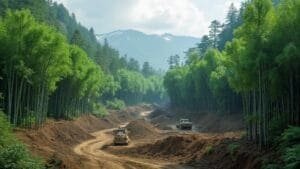Introduction
Climate change is emerging as a significant factor influencing red panda populations, with rising temperatures and shifting weather patterns threatening their habitats
These changes disrupt bamboo growth, alter forest ecosystems, and force red pandas to adapt their behaviors and ranges, often with detrimental consequences
This article explores the ways climate change impacts red pandas, from habitat shifts to reproduction challenges, and highlights strategies conservationists are employing to mitigate these effects and secure the future of this iconic species
Understanding the Impact of Climate Change on Red Panda Populations
Climate change significantly alters the environments red pandas rely on for survival, affecting their primary food source, bamboo, and the availability of suitable habitats
The combination of rising temperatures, shifting precipitation patterns, and habitat fragmentation poses serious threats to red panda populations
This section examines how climate change disrupts bamboo availability, alters habitat conditions, and contributes to forest fragmentation
Climate Change and Its Effect on Bamboo Availability
Bamboo forms the foundation of red pandas’ diet, comprising up to 95% of their food intake
However, bamboo is highly sensitive to climatic conditions, requiring specific temperature and moisture levels to thrive. Climate change disrupts these conditions, causing bamboo forests to decline in both quality and quantity
Warming temperatures at lower altitudes are pushing bamboo growth to higher elevations. This shift reduces the total area available for bamboo, as higher altitudes often lack the soil conditions or space needed to support large bamboo groves
Additionally, bamboo’s reproductive cycle, which involves periodic die-offs followed by regeneration, is being disrupted by erratic weather patterns, further threatening its availability
A study published in Global Ecology and Biogeography (2021) revealed that under moderate climate change scenarios, up to 37% of bamboo habitats in red panda ranges could disappear by 2100
This decline directly impacts red panda populations, forcing them to expand their ranges in search of food and increasing their vulnerability to predation and human-wildlife conflict
Temperature Shifts and Habitat Alteration for Red Pandas
Rising temperatures are reshaping the ecosystems that red pandas inhabit. The temperate forests of the Himalayas and southwestern China, where red pandas live, are experiencing changes in vegetation composition as warmer conditions favor different plant species
These shifts disrupt the balance of biodiversity, often crowding out bamboo and other plants essential for red pandas
Temperature increases also drive red pandas to higher elevations in search of cooler conditions. While this migration temporarily provides relief, it reduces the space available for other species at higher altitudes, creating competition for resources
Moreover, as red pandas move higher, they face harsher weather conditions and limited bamboo availability, further stressing their survival
Changes in temperature also affect the timing of natural cycles, such as flowering and fruiting periods of forest plants. This mismatch can create seasonal food shortages, particularly in areas where bamboo growth is already compromised
The Role of Climate Change in Habitat Fragmentation
Climate change exacerbates habitat fragmentation by compounding the effects of deforestation, agriculture, and urbanization. Rising temperatures and changing precipitation patterns degrade forest health, making some areas less hospitable for red pandas
Fragmented habitats isolate red panda populations, reducing genetic diversity and increasing the risk of inbreeding. Additionally, isolated populations have fewer options for migration, leaving them trapped in areas with dwindling resources
This fragmentation also limits the effectiveness of conservation efforts, as small, scattered habitats are more difficult to manage and protect
Efforts to mitigate fragmentation include creating wildlife corridors to connect isolated habitats and restoring degraded forest areas. These initiatives are essential for preserving red panda populations in the face of climate-induced habitat changes
Ecological and Behavioral Responses to Climate Change
As climate change reshapes the ecosystems red pandas inhabit, these animals must adapt their behaviors and ranges to survive
However, these adaptations often come at a cost, impacting their reproduction, survival rates, and interactions with other species. Extreme weather events further complicate their ability to thrive in an already vulnerable environment
Red Panda Range Shifts Due to Rising Temperatures
Rising temperatures are driving red pandas to seek refuge at higher altitudes where conditions remain cooler and bamboo can still grow
Studies have observed red panda populations migrating upward by several hundred meters over recent decades, following bamboo availability and escaping the heat
While these range shifts provide temporary relief, they present new challenges. Higher elevations often have steeper terrain, limited vegetation cover, and lower bamboo density, making it harder for red pandas to find sufficient food and shelter
Furthermore, the upward migration of red pandas compresses their habitat into smaller areas, increasing competition with other species also moving to higher altitudes due to climate change
This phenomenon, known as “elevation squeeze,” leaves red pandas with fewer viable habitats over time. For example, a 2019 study in Conservation Biology found that under severe climate change scenarios, more than half of red panda habitats could become unsuitable due to the combined effects of warming and habitat fragmentation
Reproductive Challenges Linked to Climate Change
Climate change affects not only where red pandas live but also their ability to reproduce successfully. Temperature shifts and habitat degradation reduce the availability of resources essential for red panda reproduction, such as dense vegetation for nesting and sufficient bamboo for nursing mothers
Extreme weather events, such as heavy rainfall or prolonged droughts, can disrupt breeding seasons and reduce the survival rates of cubs. For example, flooding caused by erratic rainfall patterns may destroy red panda dens, leaving young cubs exposed to predators and harsh weather
Additionally, stress caused by habitat loss and increased competition for resources can negatively impact red pandas’ reproductive success. Research has shown that animals under chronic stress often have lower fertility rates, further compounding the decline in red panda populations
The Impact of Extreme Weather on Red Panda Survival
Extreme weather events, which are becoming more frequent due to climate change, pose significant threats to red pandas. Droughts reduce bamboo growth, leading to food shortages, while intense storms and heavy snowfall can destroy red panda habitats and impede their ability to forage
Wildfires, another consequence of changing climate conditions, are particularly devastating for red pandas. Fires destroy large swaths of forest, reducing both shelter and food availability
In recent years, increased wildfire activity in red panda habitats has led to population declines, with some areas taking decades to recover fully
Cold snaps and prolonged winters, though less common with global warming, can still occur in high-altitude regions and exacerbate food scarcity during critical feeding periods. Such conditions force red pandas to expend more energy searching for food, weakening their overall health and reducing survival rates
Conservation strategies must address these extreme weather challenges by creating climate-resilient habitats and developing rapid response plans to protect red pandas during natural disasters
Strategies to Mitigate Climate Change Effects on Red Pandas
To counter the impacts of climate change on red panda populations, conservation efforts must focus on habitat restoration, community engagement, and international collaboration
These strategies aim to create climate-resilient ecosystems while supporting sustainable coexistence between humans and wildlife
Habitat Restoration and Climate-Resilient Conservation
Habitat restoration is a vital component of mitigating climate change’s effects on red pandas. Efforts include reforesting degraded areas, planting bamboo species that are more resilient to temperature changes, and creating wildlife corridors to connect fragmented habitats
For example, in eastern Nepal, conservation programs have restored degraded bamboo forests, enabling red pandas to access food and shelter even as climate conditions shift. These projects often focus on higher elevations, anticipating the upward migration of red pandas due to rising temperatures
Creating protected areas with buffer zones helps safeguard red panda habitats from human encroachment and provides ecosystems with the stability needed to withstand climate-related disruptions
Integrating climate change projections into land management plans ensures that restored habitats remain viable in the long term
Community Involvement in Climate Adaptation Efforts
Local communities play a crucial role in red panda conservation. Many residents living in red panda habitats depend on forests for their livelihoods, making them essential partners in sustainable land-use practices
Education programs inform communities about the importance of red pandas and the effects of climate change on forest ecosystems. Conservation organizations often train locals in climate-adaptive farming techniques, such as agroforestry, which reduces deforestation and helps maintain biodiversity
In regions like Bhutan and India, community-based initiatives have empowered residents to monitor red panda populations and report threats, such as illegal logging or poaching. These programs create a sense of stewardship, ensuring that conservation goals align with local needs
Additionally, ecotourism initiatives provide an alternative income source, reducing the economic pressures that drive habitat destruction. In areas like Ilam, Nepal, red panda-focused tourism has successfully generated revenue that supports both conservation projects and local development
International Collaboration for Long-Term Red Panda Conservation
Red pandas inhabit a transboundary range, spanning Nepal, Bhutan, India, Myanmar, and China. Climate change’s widespread impacts necessitate international collaboration to address the challenges these animals face
Programs like the Red Panda Network and the Global Snow Leopard and Ecosystem Protection Program have facilitated cross-border cooperation, enabling governments and conservation groups to share data, resources, and strategies. These partnerships focus on creating region-wide conservation corridors and standardizing climate adaptation measures
International funding mechanisms, such as the Global Environment Facility (GEF), provide critical resources for implementing large-scale conservation projects
Research collaborations also enhance understanding of how climate change affects red pandas, guiding evidence-based decision-making for future initiatives
By fostering collaboration at local, national, and global levels, conservationists can develop comprehensive strategies that ensure the long-term survival of red pandas in a changing climate
Conclusion
Climate change is profoundly altering red panda population trends by disrupting their habitats, reducing bamboo availability, and increasing the frequency of extreme weather events
As these environmental shifts force red pandas to adapt, they face additional challenges, such as habitat fragmentation, competition for resources, and reproductive stress. Without intervention, these impacts could lead to significant declines in red panda populations
Conservation strategies aimed at mitigating the effects of climate change focus on restoring habitats, creating wildlife corridors, and involving local communities in sustainable practices
By fostering international collaboration and incorporating climate resilience into conservation efforts, organizations are working to safeguard red pandas and the ecosystems they inhabit
Addressing the threats of climate change requires a unified approach that combines scientific research, policy reform, and community participation
Protecting red pandas is not only essential for preserving biodiversity but also for maintaining the health and stability of the temperate forests they call home. Through continued dedication, it is possible to secure a future where red pandas can thrive despite the challenges posed by a warming planet











